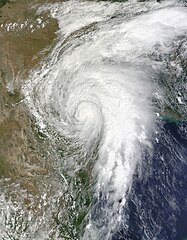Tireman4 wrote:Ms Screamer,
Could you move the fans a little more our way? This pesky high pressure ridge of death is right over us. Just a nudge. Thank you ma'am.
Signed
The Texas Desert
Oh ((((Tireman))) wish that I could. August 16th and Aug 18th are the only days we are forecasted to have wind directly from the north/northwest and at the most it is only supposed to be moving at 20 km/h (that and my fans/turbines just won't have a hope against that horrendous ridge that is sitting over you folks).
Even the fabled prairie winds are working against Texas.
I truly do hope a lot of your wildlife hightailed it outta there and headed north (hopefully however your nasty critters like the fireants etc stayed there and fried). Must admit some of those critters are why I am grateful for the cold we get (it has a nastier bite but it ain't a creepy crawler).
Must also admit I sat in our local park today watching the young ducklings and geese and whispered to them they had better be prepared for a long flight (I'm not sure how far down they'd have to go in Central/South America to reach decent wintering grounds). This is just sad beyond belief (praying especially for the poor Whooping Cranes).
"Whooping Crane occurs exclusively in North America. The historic mid-continental breeding range stretched from Alberta/Saskatchewan across the northeastern portions of the mid-continental prairies to near the southern end of Lake Michigan. The historic wintering grounds included the highlands of northern Mexico, the Texas Gulf coast, and portions of the Atlantic coast. Non-migratory populations occurred in Louisiana and possibly other areas in the southeastern United States. The species declined rapidly in the late 1800s and early 1900s as a result of hunting, collecting, and the conversion of its habitats to agriculture. By 1940, only the one self-sustaining flock remained. "
"Viewing is restricted at the whooping crane nesting grounds in Wood Buffalo National Park, located on the boundary of Alberta and the Northwest Territories. And while boat tours are offered at the wintering grounds in Aransas National Wildlife Refuge on the Texas Gulf, there's growing concern about the effects of tourism and commercial shipping in the fragile wetlands.
That makes Saskatchewan, the staging area for the 4,000-kms (2,500-mile) migration, one of the best places in the world to observe the elegant cranes. The environment is stable, the birds are widely dispersed throughout it, and it's accessible while thinly populated. Whooping cranes can linger more than a month here while foraging for the grain that fuels their long trip."










